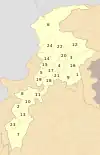| Districts of Pakistan | |
|---|---|
 | |
| Category | Administrative division |
| Location | Administrative units of Pakistan |
| Number | 170 (as of 2023) |
| Populations | Greatest: Lahore, Punjab — 11,126,285 (2017)[1] Least: Awaran, Balochistan — 121,660 (2017)[1] |
| Areas | Largest: Chagai, Balochistan — 44,748 km2 (17,277 sq mi) Smallest: Karachi Central, Sindh — 69 km2 (27 sq mi) |
| Government | |
| Subdivisions | |
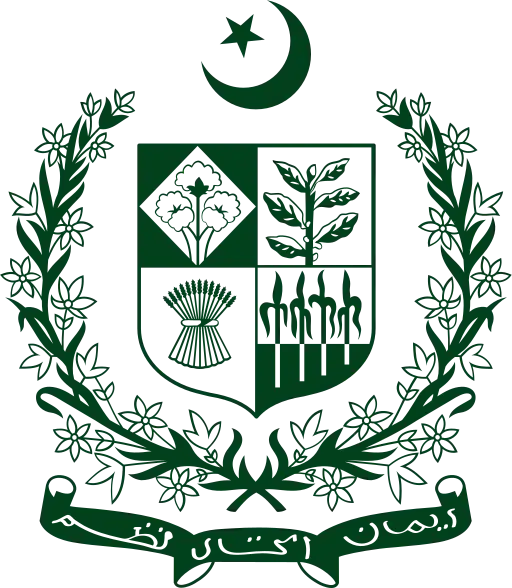 |
|---|
|
|
The Districts of Pakistan (Urdu: اِضلاعِ پاكِستان) are the third-order administrative divisions of Pakistan, below provinces and divisions, but forming the first-tier of local government. In total, there are 170 districts in Pakistan including the Capital Territory and the districts of Azad Kashmir and Gilgit Baltistan.[2][3] These districts are further divided into Tehsils, Union Councils.
History
In 1947, when Pakistan gained independence there were 124 districts. In 1969, 2 new districts (Tangail and Patuakhali) in East Pakistan were formed totalling to 126. After the Independence of Bangladesh, Pakistan lost 20 of its districts and so there were 106 districts. In 2001, the number was reduced to 102 by the merger of the 5 districts of Karachi Central, Karachi East, Karachi South, Karachi West and Malir to form Karachi District. The number of districts rose to 106 again in December 2004, when four new districts were created in the province of Sindh of which one (Umerkot) had existed until 2000 and three districts (Kashmore, Qambar and Jamshoro) were newly created.[4][lower-alpha 1] The new districts were carved out of Mirpur Khas, Jacobabad, Larkana and Dadu Districts respectively. In May 2005, the Punjab provincial government created a new district by raising the status of Nankana Sahib from a tehsil of Sheikhupura District to a district in its own right.[5][lower-alpha 2] On 11 July 2011, the Sindh Government restored again the districts of Karachi South, Karachi East, Malir, Karachi West and Karachi Central, then later in 2013, the district of Korangi was carved out of Karachi East District. In Azad Jammu and Kashmir, a second-tier of government was formed from three administrative divisions into ten districts. In Gilgit–Baltistan, there are ten districts divided between the two regions of Gilgit and Baltistan. In 2018, Federally Administered Tribal Areas (FATA) was merged with Khyber Pakhtunkhwa province and FATA agencies were converted into districts.
Chagai is the largest district of Pakistan by area while Lahore District is the largest by population with a total population of 11,126,285 at the 2017 census. Quetta is the largest district of Balochistan by population with a total population of 2,275,699 at the 2017 census. Bahawalpur is the largest district of Punjab by area. Chitral is the largest by area and Peshawar is the largest by population from Khyber Pakhtunkhwa with the population of 4,269,079 at the Census 2017. Sindh's largest district by area is Tharparkar[6] and by population its Karachi West with a population of 3,914,757 at the 2017 Census. The combined population of the six districts of Karachi division is over 16 million at the 2017 census, giving an average population for these six districts of Karachi division of over 2.675 million each. Neelum and Kotli are the largest districts of Azad Kashmir by area and population respectively. Gilgit is the largest by area and population both for Gilgit-Baltistan.
Administration
Deputy commissioner
A deputy commissioner (popularly abbreviated to "DC") is the executive head of the district. Deputy commissioners are appointed by the government from the Pakistan Administrative Service.
District council
A district council (or zila council) is a local government body at the district level.
The functions of a district council include construction and maintenance of roads, and bridges, building hospitals and dispensaries, schools and educational institutions, health facilities and sanitation, tube wells for drinking water, rest houses, and coordination of activities of the Union councils within the district.
Provinces and Territories
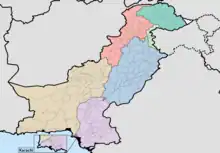
| Sr. No. | States / Provinces | Divisions | Districts | Area (km2) |
Population (2017)[7] |
Density (people/km2) |
|---|---|---|---|---|---|---|
| 1 | Azad Jammu and Kashmir | 3 | 10 | 13,297 | 4,045,366 | 304.23 |
| 2 | Balochistan | 8[8] | 36[9] | 347,190 | 12,344,408 | 35.55 |
| 3 | Gilgit-Baltistan | 3 | 14 | 72,971 | 1,492,924 | 47.96 |
| 4 | Islamabad Capital Territory | 1 | 1 | 906 | 2,006,572 | 2,214.76 |
| 5 | Khyber Pakhtunkhwa | 7[8] | 38[8] | 101,741 | 35,525,047 | 349.17 |
| 6 | Punjab | 11[8] | 42[10] | 205,344 | 110,012,442 | 535.74 |
| 7 | Sindh | 7[8] | 30[11] | 140,914 | 47,886,051 | 339.82 |
Azad Jammu and Kashmir

| # | District | Headquarters | Area (km2) |
Population (1998)[12] |
Population (2017)[12] |
Density (people/km2) |
Division |
|---|---|---|---|---|---|---|---|
| 1 | Muzaffarabad | Muzaffarabad | 1,642 | 453,957 | 650,370 | 394 | Muzaffarabad |
| 2 | Hattian Bala | Hattian Bala | 854 | 166,064 | 230,529 | 270 | Muzaffarabad |
| 3 | Neelum | Athmuqam | 3,621 | 125,712 | 191,251 | 53 | Muzaffarabad |
| 4 | Mirpur | Mirpur | 1,010 | 333,482 | 456,200 | 452 | Mirpur |
| 5 | Bhimber | Bhimber | 1,516 | 301,633 | 420,624 | 297 | Mirpur |
| 6 | Kotli | Kotli | 1,862 | 563,134 | 774,194 | 416 | Mirpur |
| 7 | Poonch | Rawalakot | 855 | 411,035 | 500,571 | 585 | Poonch |
| 8 | Bagh | Bagh | 770 | 281,721 | 371,919 | 483 | Poonch |
| 9 | Haveli | Forward Kahuta | 598 | 111,694 | 152,124 | 254 | Poonch |
| 10 | Sudhnati | Pallandari | 569 | 224,091 | 297,584 | 523 | Poonch |
Balochistan
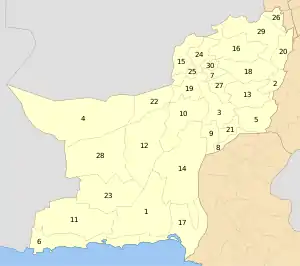
| Sr. No. | District | Headquarters | Area (km2) |
Population (2017)[13] |
Density (people/km2) |
Division |
|---|---|---|---|---|---|---|
| 1 | Awaran | Awaran | 29,510[14] | 956,011 | 4 | Kalat |
| 2 | Barkhan | Barkhan | 3,514 | 171,556 | 48.8 | Loralai |
| 3 | Chagai | Dalbandin | 44,748[15] | 226,008 | 5 | Rakhshan |
| 4 | Chaman | Chaman | Quetta | |||
| 5 | Dera Bugti | Dera Bugti | 10,160 | 1,500,603 | 31 | Sibi |
| 6 | Duki | Duki | 153,000 | Loralai | ||
| 7 | Gwadar | Gwadar | 12,637 | 4,500,514 | 21 | Makran |
| 8 | Harnai[16] | Harnai | 4,096 | 97,017 | 24 | Sibi |
| 9 | Hub | Hub | 6,716 | 339,640 | 51 | Kalat |
| 10 | Jafarabad | Dera Allahyar | 2,445 | 513,813 | 210 | Nasirabad |
| 11 | Jhal Magsi | Gandava | 3,615 | 149,225 | 41 | Nasirabad |
| 12 | Kachhi | Dhadar | 7,499 | 237,030 | 32 | Nasirabad |
| 13 | Kalat | Kalat | 6,622 | 412,232 | 62 | Kalat |
| 14 | Kech | Turbat | 22,539 | 909,116 | 40 | Makran |
| 15 | Kharan | Kharan | 8,958 | 156,152 | 17 | Rakhshan |
| 16 | Khuzdar | Khuzdar | 35,380 | 802,207 | 23 | Kalat |
| 17 | Kohlu | Kohlu | 7,610 | 214,350 | 28 | Sibi |
| 18 | Lasbela | Uthal | 15,153 | 574,292 | 38 | Kalat |
| 19 | Loralai | Loralai | 9,830 | 397,400 | 40 | Loralai |
| 20 | Mastung | Mastung | 5,896 | 266,461 | 45 | Kalat |
| 21 | Musakhel | Musa Khel Bazar | 5,728 | 167,017 | 29 | Loralai |
| 22 | Nasirabad | Dera Murad Jamali | 3,387 | 490,538 | 145 | Nasirabad |
| 23 | Nushki[17] | Nushki | 5,797 | 178,796 | 31 | Rakhshan |
| 24 | Panjgur | Panjgur | 16,891 | 316,385 | 19 | Makran |
| 25 | Pishin | Pishin | 7,819 | 736,481 | 94 | Quetta |
| 26 | Quetta | Quetta | 2,653 | 2,275,699 | 858 | Quetta |
| 27 | Qila Abdullah | Jungle Pir Alizai | 3,293 | 757,578 | 230 | Quetta |
| 28 | Qilla Saifullah | Qilla Saifullah | 6,831 | 342,814 | 50 | Zhob |
| 29 | Sherani | Sherani | 2,800 | 153,116 | 55 | Zhob |
| 30 | Sibi | Sibi | 7,796 | 135,572 | 17 | Sibi |
| 31 | Sohbatpur | Sohbatpur | 1,412 | 200,538 | 142 | Nasirabad |
| 32 | Surab | Surab | - | - | - | Kalat |
| 33 | Washuk | Washuk | 29,510 | 176,206 | 6 | Rakhshan |
| 34 | Zhob | Zhob | 20,297 | 310,544 | 15 | Zhob |
| 35 | Ziarat | Ziarat | 1,489 | 160,422 | 108 | Kalat |
| 36 | Usta Muhammad | Usta Muhammad | N/A | N/A | N/A | Nasirabad |
Gilgit Baltistan


| # | District | Headquarters | Area (km2) |
Population (1998) |
Division |
|---|---|---|---|---|---|
| 1 | Ghanche | Khaplu | 6,400 | 88,366 | Baltistan |
| 2 | Skardu | Skardu | 15,000 | 214,848 | Baltistan |
| 3 | Astore | Eidghah | 8,657 | 71,666 | Diamer |
| 4 | Diamer | Chilas | 10,936 | 131,925 | Diamer |
| 5 | Ghizer | Gahkuch | 9,635 | 120,218 | Gilgit |
| 6 | Gilgit | Gilgit | 38,000 | 243,324 | Gilgit |
| 7 | Hunza | Karimabad | 17,145 | 80,355 | Gilgit |
| 8 | Kharmang | Tolti | 20,000[18] | Baltistan | |
| 9 | Shigar | Shigar | 8,500 | 109,000 | Baltistan |
| 10 | Nagar | Nagarkhas | 15,567 | 89,420 | Gilgit |
| 11 | Gupis–Yasin | Phander | Gilgit | ||
| 12 | Tangir | Tangir | Diamer | ||
| 13 | Darel | Darel | Diamer | ||
| 14 | Roundu | Dambudas | Baltistan |
Khyber Pakhtunkhwa

| Sr. No. | District | Headquarters | Area (km2) |
Population (2017)[1] |
Density (people/km2) |
Division |
|---|---|---|---|---|---|---|
| 1 | Abbottabad | Abbottabad | 1,967 | 1,332,912 | 785 | Hazara |
| 2 | Allai | Allai Valley | N/A | N/A | N/A | Hazara |
| 3 | Bajaur | Khar | 1,290 | 1,093,684 | 848 | Malakand |
| 4 | Bannu | Bannu | 1,227 | 1,167,892 | 952 | Bannu |
| 5 | Battagram | Battagram | 1,301 | 476,612 | 366 | Hazara |
| 6 | Buner | Daggar | 1,865 | 897,319 | 481 | Malakand |
| 7 | Charsadda | Charsadda | 996 | 1,616,198 | 1,623 | Peshawar |
| 8 | Central Dir District | Wari | Malakand | |||
| 9 | Dera Ismail Khan | Dera Ismail Khan | 9,334 | 1,627,132 | 222 | Dera Ismail Khan |
| 10 | Hangu | Hangu | 1,097 | 518,798 | 473 | Kohat |
| 11 | Haripur | Haripur | 1,725 | 1,003,031 | 581 | Hazara |
| 12 | Karak | Karak | 3,372 | 706,299 | 209 | Kohat |
| 13 | Khyber | Landi Kotal | 2,576 | 986,973 | 383 | Peshawar |
| 14 | Kohat | Kohat | 2,545 | 993,874 | 390 | Kohat |
| 15 | Kurram | Parachinar | 3,380 | 619,553 | 201 | Kohat |
| 16 | Kolai Palas | Kolai | - | - | - | Hazara |
| 17 | Lakki Marwat | Lakki Marwat | 3,164 | 876,182 | 277 | Bannu |
| 18 | Lower Dir | Timergara | 1,582 | 1,435,917 | 908 | Malakand |
| 19 | Lower Kohistan | Pattan | 7,492 | 784,711* | 105 | Hazara |
| 20 | Lower Chitral | Chitral | 7,492 | 784,711* | 105 | Malakand |
| 21 | Malakand | Batkhela | 952 | 720,295 | 757 | Malakand |
| 22 | Mansehra | Mansehra | 4,579 | 1,556,460 | 340 | Hazara |
| 23 | Mardan | Mardan | 1,632 | 2,373,061 | 1,454 | Mardan |
| 24 | Mohmand | Ghalanai | 2,296 | 466,984 | 203 | Peshawar |
| 25 | North Waziristan | Miranshah | 4,707 | 543,254 | 115 | Bannu |
| 26 | Nowshera | Nowshera | 1,748 | 1,518,540 | 869 | Peshawar |
| 27 | Orakzai | Kalaya | 1,538 | 254,356 | 165 | Kohat |
| 28 | Peshawar | Peshawar | 1,257 | 4,269,079 | 3,396 | Peshawar |
| 29 | Shangla | Alpuri | 1,586 | 757,810 | 478 | Malakand |
| 30 | Upper South Waziristan | Spinkai | Dera Ismail Khan | |||
| 31 | Lower South Waziristan | Wana | Dera Ismail Khan | |||
| 32 | Swabi | Swabi | 1,543 | 1,624,616 | 1,053 | Mardan |
| 33 | Swat | Saidu Sharif | 5,337 | 2,309,570 | 433 | Malakand |
| 34 | Tank | Tank | 1,679 | 391,885 | 233 | Dera Ismail Khan |
| 35 | Torghar | Judba | 497 | 171,395 | 345 | Hazara |
| 36 | Upper Dir | Dir | 3,699 | 946,421 | 256 | Malakand |
| 37 | Upper Kohistan | Dasu | 7,492 | 784,711* | 105 | Hazara |
| 38 | Upper Chitral | Booni | - | - | - | Malakand |
Note: Recently merged 7 agencies and Frontier Regions of FATA in Khyber Pakhtunkhwa included in the list. Population and area of Frontier Regions is merged in respective districts.
Punjab
_Districts.svg.png.webp)
| Sr. No. | District | Headquarters | Area (km2) |
Population (2017) |
Density (people per km2) |
Division |
|---|---|---|---|---|---|---|
| 1 | Attock | Attock | 6,858 | 1,883,556 | 275 | Rawalpindi |
| 2 | Bahawalnagar | Bahawalnagar | 8,878 | 2,981,919 | 336 | Bahawalpur |
| 3 | Bahawalpur | Bahawalpur | 24,830 | 3,668,106 | 148 | Bahawalpur |
| 4 | Bhakkar | Bhakkar | 8,153 | 1,650,518 | 202 | Mianwali |
| 5 | Chakwal | Chakwal | 6,524 | 1,495,982 | 229 | Rawalpindi |
| 6 | Chiniot | Chiniot | 2,643 | 1,369,740 | 518 | Faisalabad |
| 7 | Dera Ghazi Khan | Dera Ghazi Khan | 11,922 | 2,872,201 | 241 | Dera Ghazi Khan |
| 8 | Faisalabad | Faisalabad | 5,856 | 7,873,910 | 1,345 | Faisalabad |
| 9 | Gujranwala | Gujranwala | 3,622 | 5,014,196 | 1,384 | Gujranwala |
| 10 | Gujrat | Gujrat | 3,192 | 2,756,110 | 863 | Gujrat |
| 11 | Hafizabad | Hafizabad | 2,367 | 1,156,957 | 489 | Gujrat |
| 12 | Jampur | Jampur | N/A | N/A | N/A | Dera Ghazi Khan |
| 13 | Jhang | Jhang | 8,809 | 2,743,416 | 311 | Faisalabad |
| 14 | Jhelum | Jhelum | 3,587 | 1,222,650 | 341 | Rawalpindi |
| 15 | Kasur | Kasur | 4,796 | 3,454,996 | 720 | Lahore |
| 16 | Khanewal | Khanewal | 4,349 | 2,921,986 | 672 | Multan |
| 17 | Khushab | Jauharabad | 6,511 | 1,281,299 | 197 | Sargodha |
| 18 | Lahore | Lahore | 1,772 | 11,126,285 | 6,279 | Lahore |
| 19 | Layyah | Layyah | 6,291 | 1,824,230 | 290 | Dera Ghazi Khan |
| 20 | Lodhran | Lodhran | 2,778 | 1,700,620 | 612 | Multan |
| 21 | Mandi Bahauddin | Mandi Bahauddin | 2,673 | 1,593,292 | 596 | Gujrat |
| 22 | Mianwali | Mianwali | 5,840 | 1,546,094 | 265 | Mianwali |
| 23 | Multan | Multan | 3,720 | 4,745,109 | 1,275 | Multan |
| 24 | Muzaffargarh | Muzaffargarh | 8,249 | 4,322,009 | 524 | Dera Ghazi Khan |
| 25 | Narowal | Narowal | 2,337 | 1,709,757 | 732 | Gujranwala |
| 26 | Nankana Sahib[5] | Nankana Sahib | 2,960 | 1,356,374 | 458 | Lahore |
| 27 | Okara | Okara | 4,377 | 3,039,139 | 694 | Sahiwal |
| 28 | Pakpattan | Pakpattan | 2,724 | 1,823,687 | 669 | Sahiwal |
| 29 | Rahim Yar Khan | Rahim Yar Khan | 11,880 | 4,814,006 | 405 | Bahawalpur |
| 30 | Rajanpur | Rajanpur | 12,319 | 1,995,958 | 162 | Dera Ghazi Khan |
| 31 | Rawalpindi | Rawalpindi | 5,286 | 5,405,633 | 1,322 | Rawalpindi |
| 32 | Sahiwal | Sahiwal | 3,201 | 2,517,560 | 786 | Sahiwal |
| 33 | Sargodha | Sargodha | 5,854 | 3,703,588 | 633 | Sargodha |
| 34 | Sheikhupura | Sheikhupura | 3,030 | 3,460,426 | 1,142 | Lahore |
| 35 | Sialkot | Sialkot | 3,016 | 3,893,672 | 1,291 | Gujranwala |
| 36 | Toba Tek Singh | Toba Tek Singh | 3,252 | 2,190,015 | 673 | Faisalabad |
| 37 | Vehari | Vehari | 4,364 | 2,897,446 | 664 | Multan |
| 38 | Talagang | Talagang | 2999 | 527,756 | 180 | Rawalpindi |
| 39 | Murree | Murree | N/A | N/A | N/A | Rawalpindi |
| 40 | Taunsa | Taunsa | N/A | N/A | N/A | Dera Ghazi Khan |
| 41 | Kot Addu | Kot Addu | N/A | N/A | N/A | Dera Ghazi Khan |
| 42 | Wazirabad | Wazirabad | N/A | N/A | N/A | Gujrat |
Sindh
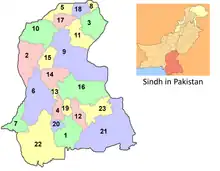
| Sr. No. | District | Headquarters | Area (km2) |
Population (2017) |
Density (people/km2) |
Division |
|---|---|---|---|---|---|---|
| 1 | Badin | Badin | 6,726 | 1,804,516 | 268 | Banbhore |
| 2 | Dadu | Dadu | 7,866 | 1,550,266 | 197 | Hyderabad |
| 3 | Ghotki | Mirpur Mathelo | 6,083 | 1,646,318 | 270 | Sukkur |
| 4 | Hyderabad | Hyderabad | 5,519 | 2,199,463 | 398 | Hyderabad |
| 5 | Jacobabad | Jacobabad | 5,278 | 1,006,297 | 191 | Larkana |
| 6 | Jamshoro | Jamshoro | 11,250 | 993,142 | 88 | Hyderabad |
| 7 | Karachi Central | North Nazimabad | 69 | 2,971,626 | 43,067 | Karachi |
| 8 | Karachi East | Gulshan e Iqbal | 165 | 2,907,467 | 17,610 | Karachi |
| 9 | Karachi South | Saddar Karachi | 122 | 1,791,751 | 14,686 | Karachi |
| 10 | Karachi West | Orangi Town | 929 | 3,914,757 | 4,214 | Karachi |
| 11 | Kashmore | Kandhkot | 2,592 | 1,089,169 | 420 | Larkana |
| 12 | Khairpur | Khairpur | 15,910 | 2,404,334 | 151 | Sukkur |
| 13 | Korangi | Korangi | 95 | 2,457,019 | 25,918 | Karachi |
| 14 | Keamari | Moriro Mirbahar | - | - | - | Karachi |
| 15 | Larkana | Larkana | 1,906 | 1,524,391 | 205 | Larkana |
| 16 | Malir | Malir | 2,268 | 2,008,901 | 886 | Karachi |
| 17 | Matiari | Matiari | 1,417 | 769,349 | 543 | Hyderabad |
| 18 | Mirpur Khas | Mirpur Khas | 2,925 | 1,505,876 | 515 | Mirpur Khas |
| 19 | Naushahro Feroze | Naushahro Feroze | 2,945 | 1,612,373 | 548 | Shaheed Benazir Abad |
| 20 | Qambar Shahdadkot | Qambar | 5,599 | 1,341,042 | 239 | Larkana |
| 21 | Sanghar | Sanghar | 10,720 | 2,057,057 | 192 | Mirpur Khas |
| 22 | Shaheed Benazirabad | Nawabshah | 4,502 | 1,612,847 | 358 | Shaheed Benazirabad |
| 23 | Shikarpur | Shikarpur | 2,512 | 1,231,481 | 490 | Larkana |
| 24 | Sujawal | Sujawal | 8,699[19] | 781,967 | 106 | Banbhore |
| 25 | Sukkur | Sukkur | 2,512 | 1,487,903 | 592 | Sukkur |
| 26 | Tando Allahyar | Tando Allahyar | 5,165 | 836,887 | 162 | Hyderabad |
| 27 | Tando Muhammad Khan | Tando Muhammad Khan | 2,310 | 677,228 | 293 | Hyderabad |
| 28 | Tharparkar | Mithi | 19,638 | 1,649,661 | 84 | Mirpur Khas |
| 29 | Thatta | Thatta | 7,705[6] | 979,817 | 98 | Banbhore |
| 30 | Umerkot[20] | Umerkot | 5,608[6] | 1,073,146 | 191 | Mirpur Khas |
See also
Notes
All the figures require being re-checked. Data entry error has occurred in Sindh Province.
References
- 1 2 3 "District Wise Census Results – Census 2017" (PDF). www.pbscensus.gov.pk. Archived from the original (PDF) on 29 August 2017. Retrieved 3 September 2017.
- ↑ "Dividing governance: Three new districts notified in G-B – The Express Tribune". The Express Tribune. 26 July 2015. Retrieved 5 April 2019.
- ↑ "Administrative Setup". ajk.gov.pk. Archived from the original on 9 April 2010. Retrieved 17 May 2010.
- ↑ "Four new districts in Sindh". Daily Times. 11 December 2004. Archived from the original on 11 December 2013. Retrieved 16 February 2014.
- 1 2 "Nankana becomes district". Dawn. Pakistan. 10 May 2005. Retrieved 16 February 2014.
- 1 2 3 "Thatta (District, Pakistan) – Population Statistics, Charts, Map and Location". citypopulation.de.
- ↑ "Province Wise Provisional Results of Census – 2017" (PDF). Pakistan Bureau of Statistics. Archived from the original (PDF) on 15 November 2017.
- 1 2 3 4 5 Babakhel, Mohammad Ali (23 October 2018). "New districts". Dawn. Pakistan. Retrieved 25 April 2022.
- ↑ "New division, two districts created in Balochistan". Dawn. Pakistan. 30 June 2021. Retrieved 30 June 2021.
- ↑ "Districts | Punjab Portal". Punjab.gov.pk. 16 January 2014. Retrieved 16 February 2014.
- ↑ "Map of Sindh". Government of Sindh. Retrieved 16 February 2014.
- 1 2 Azad Government of Jammu & Kashmir, Muzaffarabad, 2019.
- ↑ "Pakistan Bureau of Statistics - 6th Population and Housing Census". www.pbscensus.gov.pk. Archived from the original on 15 October 2017. Retrieved 8 September 2017.
- ↑ "Home – Government of Balochistan" (PDF). balochistan.gov.pk. Retrieved 1 June 2018.
- ↑ "Country escapes major earthquake damage". Daily Times. 20 January 2011. Archived from the original on 11 December 2013. Retrieved 16 February 2014.
- ↑ "Harnai is new district of Balochistan". Dawn. Pakistan. 31 August 2007. Retrieved 16 February 2014.
- ↑ "Kharan and Noshki District" (PDF). American Refugee Committee. July 2007. Archived from the original (PDF) on 25 July 2011. Retrieved 16 February 2014.
- ↑ "Kharmang now GB district". Pakistan Observer. 24 March 2013. Archived from the original on 24 November 2015. Retrieved 12 December 2015.
- ↑ "Sujawal (District, Pakistan) – Population Statistics, Charts, Map and Location". citypopulation.de.
- ↑ "Historically & Geographically". District Government Umerkot. Archived from the original on 24 February 2012. Retrieved 16 February 2014.
Further reading
- Population Census Organization, Government of Pakistan. "List of Districts/Agencies/Tribal Areas". Archived from the original on 19 December 2010. Retrieved 14 April 2006.
- Population Census Organization, Government of Pakistan. "List of Tehsils/Talukas with respect to their Districts". Archived from the original on 30 December 2010. Retrieved 14 April 2006.
- Country Profiles, South Asian Media Net. "Pakistan >> District Profiles". Archived from the original on 18 May 2011. Retrieved 14 April 2006.
- "District Governments of Sindh". Local Government Department, Government of Sindh. Archived from the original on 26 November 2009. Retrieved 16 February 2014.
External links
- List of districts from the Population Census Organization (Government of Pakistan)
